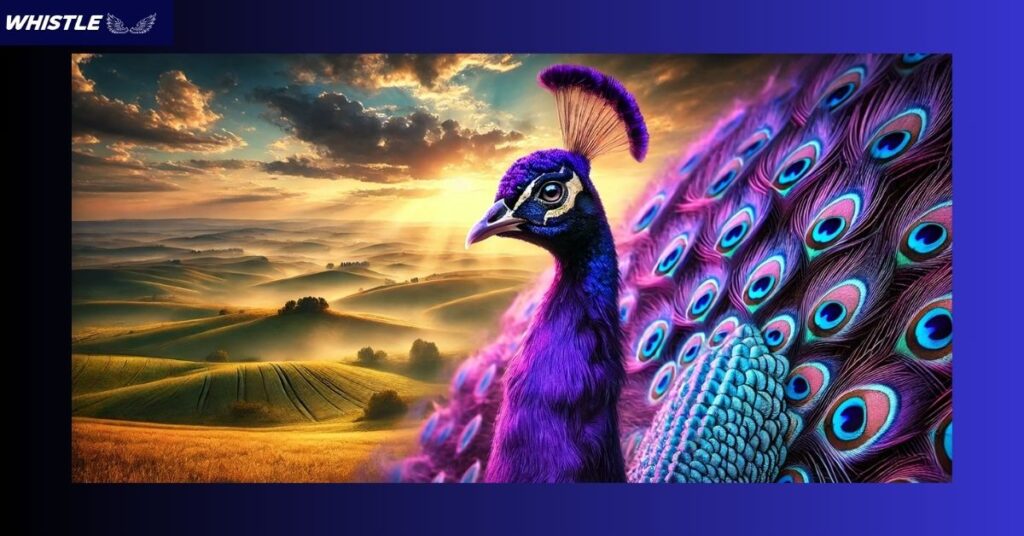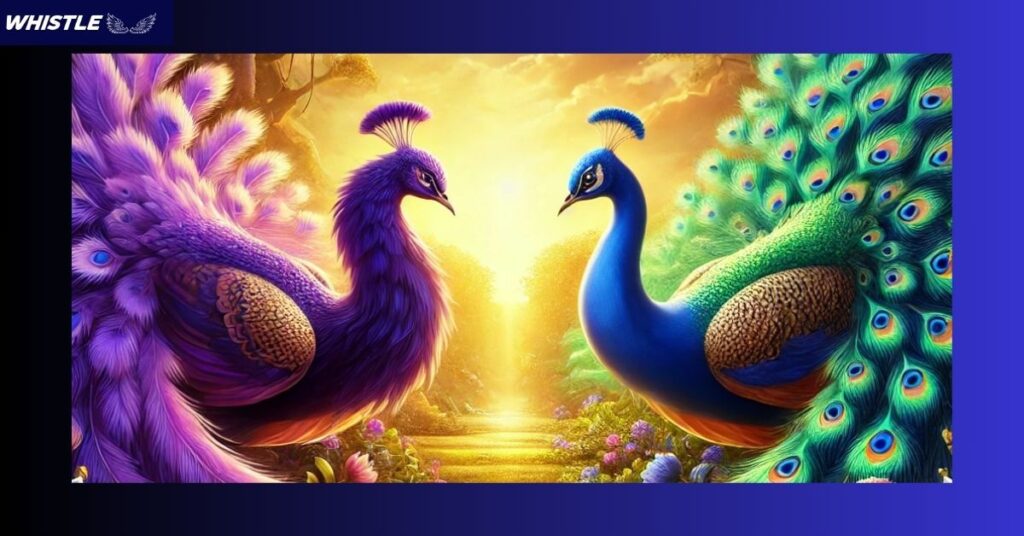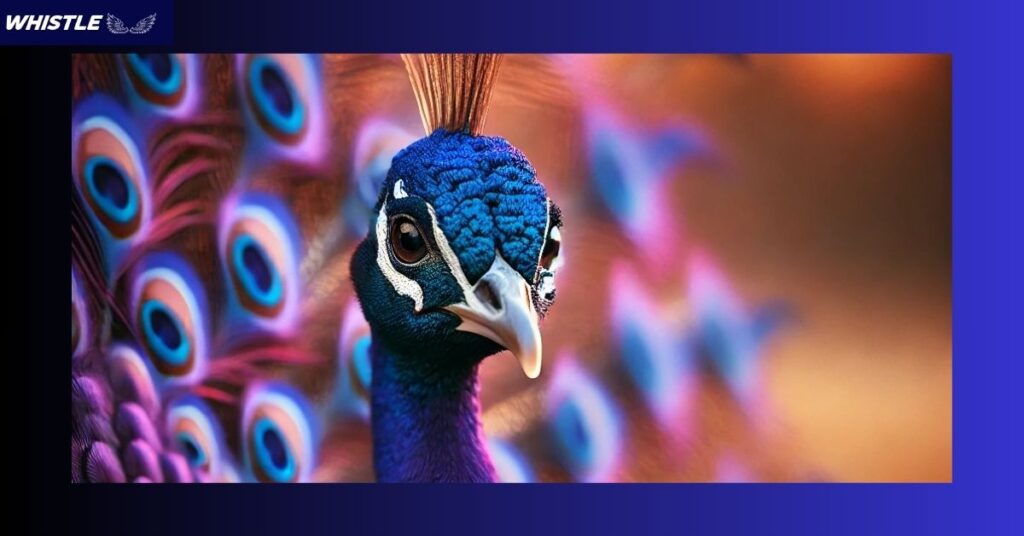Have you ever gazed in awe at the shimmering feathers of a rare Purple Peacock? This vibrant bird, with its stunning violet plumage and profound cultural significance, captures imaginations worldwide. More than just a visual marvel, it represents royalty, spirituality, and artistic inspiration.
In this detailed guide, we’ll explore the fascinating world of this unique creature, diving into its biology, habitat, cultural roles, and modern influence. Let’s embark on a colorful journey to uncover its secrets.
Key Takeaways:
- This rare peafowl variant, with its iridescent violet feathers, stems from the Indian peafowl species.
- It symbolizes royalty, beauty, and immortality in diverse global traditions and religions.
- The bird inspires art, fashion, and design, shaping trends in textiles, jewelry, and decor.
- Conservation and ethical breeding are essential to protect the peafowl species and their unique variants.
- Proper care, including diet and habitat, ensures the health and vibrancy of these magnificent birds.
Find Out the Purple Peacock’s Charm – Why Is It Unresistible?
Interestingly, this bird is not a separate species but rather an uncommon color morph of the Indian peafowl (Pavo cristatus). Compared to common blue and green peacocks, it has an intense violet color that changes color in sunlight to show indigo, magenta, and amethyst shades. This vibrant coloring is achieved through genetic mutations and selective breeding, and so these birds are a sought-after spectacle in aviaries, zoos, and private collections.

In addition, the male’s train, or tail, is the centerpiece of its beauty. Up to six feet long, the train includes long feathers with eye-spotted ocelli that glint violet hues during courtship rituals. Peahens, which are females, have brown and gray muted feathers for camouflage in nests, highlighting the species’ dramatic sexual dimorphism. The striking difference between the showy male and subdued female intrigues onlookers.
Also, the birds are famous for their bold swagger and loud calls, varying from gentle coos to harsh screeches. These actions are used to attract mates as well as delimit territories. Being rare and stunning, they are a prized acquisition for ornamental gardens and refuges. Being kept in captivity, they need specialized attention in the form of a balanced diet of grains, fruits, and insects, along with safe enclosures to keep them healthy and feathers radiant. Owners frequently mention the delight of seeing these birds spread their trains, a treat that attracts large crowds at shows.
“The Purple Peacock strides with the majesty of royalty, its plumage a work of divine artistry.” – Anonymous Wildlife Poet
Secrets of the Purple Peacock’s Glow – How Its Colors Mesmerize?
Fascinatingly, the bird’s vivid violet coloration stems from structural coloration, where microscopic feather structures refract light to produce vibrant hues. Unlike pigmentation, which relies on chemical dyes, this process creates an iridescent effect that shifts with viewing angles. These structures emphasize violet and indigo wavelengths, resulting in a breathtaking visual display.
In addition, the genetic mutations cause this specific coloration. Breeders crossbreed specific peafowl with the characteristics they desire to increase violet tones, commonly breeding Indian peafowl with green peafowl (Pavo muticus) to add new patterns. The violet mutation is not common, as it takes specific combinations of genetics not often found in the wild. This rarity contributes to the exclusivity and popularity of the bird.
Significantly, diet contributes to feather color intensity. The birds eat seeds, fruits, insects, and little reptiles that are high in carotenoids that enhance color brightness. Breeders feed captive birds on specialized diets supplemented with vitamins to improve the brightness of the feathers. Environmental conditions, such as light and moisture, influence color brightness too. Birds kept in overcast enclosures might have somewhat duller colors than those in lighted rooms, so housing design is important.
Also important is the maintenance of feathers. The males groom their trains every day to maintain clean, colorful plumage, and they molt annually so new feathers can grow in. Breeders pay close attention to molting schedules so the feathers will be at their best, since stress or suboptimal nutrition will mute colors.
More For You: Get Kids Interested in Birdwatching – 10 Proven Methods!
| Feature | Details |
| Scientific Name | Pavo cristatus (Selective Breed) |
| Common Name | Purple Peafowl |
| Color | Iridescent purple sheen |
| Origin | Selective breeding, not found in the wild |
| Size | Males: 6–7 ft, Females: 3–4 ft |
| Weight | Males: 8–13 lbs, Females: 6–9 lbs |
| Lifespan | 15–25 years |
| Diet | Grains, seeds, insects, fruits |
| Habitat | Aviaries, farms, exotic collections |
| Temperament | Social, territorial in breeding season |
| Reproduction | 3–6 eggs per clutch, spring mating |
| Cost | $500 – $2,000+ |
| Availability | Rare, found in private collections |
| Special Trait | Unique purple shimmer due to iridescence |
Where can you see Stunning Peafowl Thrive?
Interestingly, these purple-colored birds do not naturally occur in the wild since their coloration is brought about by selective breeding. They survive in a controlled environment such as zoos, wildlife sanctuaries, peafowl farms, and private estates. Their ancestor species, the Indian peafowl, is indigenous to South Asia and thrives in India, Sri Lanka, and Pakistan in environments such as deciduous forests, grasslands, and farmland close to water bodies.

For captivity, such birds require large enclosures—a minimum of 100 square feet per bird—and perches, shade, and safety fencing to replicate natural environments. Enclosures must have dust baths for grooming feathers and roosting platforms for safe nighttime roosting.
Availability of clean water avoids dehydration, which weakens feathers and compromises health. Temperature control is essential, as excessive heat or cold affects well-being. Conservation programs for peafowl in the wild center on habitat conservation, as deforestation and urbanization reduce their habitats. Organizations such as the World Pheasant Association advocate the use of sustainable land use to safeguard these stocks.
Enthusiastically, seeing these birds is exhilarating. Go to serious zoos, such as the San Diego Zoo or London Zoo, or sanctuaries like the Peafowl Preservation Society, which take animal welfare seriously. Botanical gardens and historic houses, such as India’s City Palace at Udaipur or Longleat Estate in the UK, keep them as ornamental features. Observe guidelines to maintain their health, avoiding flash photography or sudden noises that may stress them.
“While the colorful peafowl dances in the light, it reminds us of the unlimited creativity of nature.” – Jane Goodall, Primatologist
Peafowl A Legend in Culture – Learn About Its International Impact:
Interestingly, this colorful bird is imbued with profound cultural and religious meaning in civilizations. It is revered in Hinduism, being associated with Lord Krishna, whose crown is adorned with peacock feathers. The bird is a symbol of grace, beauty, and divine protection. Its images adorn temples, while dance styles such as Bharatanatyam imitate its movements, with dancers emulating its majestic strut. In Jainism, it is an emblem for non-violence, living in harmony with other beings in peace.
In addition, in Buddhism, the peacock represents purity and strength, with myths stating it eats poisonous plants without harm, representing wisdom over evil. The violet form is regarded as a strong symbol of enlightenment and immortality. Peacock imagery is common in Tibetan Buddhist mandalas, which represent spiritual balance and harmony, with violet tones giving it a mystical feel.
In Western societies, peacocks used to represent vanity because of their flamboyant displays, but the violet-colored form means exclusivity and royalty. Its picture is emblazoned on royal crests, aristocratic mansions, and ceremonial dress to signify dignity and majesty. For example, self-help books cite their distinctive beauty to promote individual development and self-assurance in varied contexts.
Worldwide, cultural events such as art exhibitions and theatrical presentations use their imagery to inspire admiration. Such widespread admiration emphasizes its status as a global sign of beauty and transcendence, linking ancient traditions with contemporary expressions.
More For You: Wood Pigeons Lifespan – How Long Do These Birds Live?
Mythical Tales – The Peafowl’s Role in Folklore
Interestingly, this bird is entwined in old myths. In Greek myth, the peacock is associated with Hera, who decorated its tail with “eyes” as a tribute to her vigilance. The violet form has sometimes been interpreted as a heavenly gift, carrying the connotation of divine wisdom and prophecy. In Chinese tradition, peacocks presage prosperity, and violet-colored ones are regarded particularly as blessings for wealth and harmony, being used frequently in imperial iconography.
Also, Persian mythology describes peacocks as guardians of paradise, their feathers symbolizing eternal gardens. Peacocks dancing before rain in Indian legend are violet ones, symbolizing rich harvests and revival. These myths, handed down through generations, capture the bird’s long-lasting fascination as a beauty symbol and emblem of divine association.
Pop Culture Phenomenon – The Peafowl’s New Reign:
In a surprising twist, the bird excels in contemporary culture. Its multicolored hue inspires social media phenomena with influencers presenting peacock-inspired art, fashion, and photography on Instagram and Pinterest. Hashtags such as #VioletPeafowl achieve tens of thousands of posts, mirroring worldwide interest. In the entertainment industry, it makes appearances in animated movies such as Kung Fu Panda, where peacock figures embody sophistication, and in books as symbols of mystery and seductiveness.
The bird affects branding. Luxury fashion brands employ their imagery for logos, labels, and commercials to convey elegance. Cosmetic brands release peacock-inspired eye shadow palettes in violet shades, while boutique hotels include violet feather patterns on decor to appeal to luxury clients. Music artists also take cues, with album artworks using peacock feathers to depict artistic richness and ingenuity
“The peacock’s tail, with its violet splendor, is a testament to the beauty of creation.” – Psalm 104:24 (Adapted)
Artistic Muse Unveiled – The Peafowl’s Runway Dominance:
Excitingly, the bird’s aesthetic captivates artists across mediums. In fine art, painters like John Singer Sargent and Gustav Klimt drew inspiration from peacock feathers, capturing their iridescence in portraits and decorative works. Modern digital artists use tools like Procreate to replicate violet hues, creating vibrant illustrations for galleries and NFT marketplaces. Art festivals feature peacock-themed installations, drawing crowds with their visual impact and intricate designs.
Fashion’s Favorite:
Intriguingly, the fashion industry celebrates the bird for its bold glamour. Runway collections feature dresses and suits adorned with peacock feather patterns, using embroidery or sequins to mimic its shimmer. Designers like Alexander McQueen and Elie Saab showcase peacock-inspired gowns, blending violet hues with metallic threads for dramatic effect. Accessories, such as handbags, scarves, and shoes, incorporate violet elements, making them standout pieces in wardrobes.
Fashion blogs highlight violet peacock trends, with influencers styling feather-inspired outfits for galas, weddings, and red-carpet events. The bird’s royal association makes it a favorite for couture collections, appealing to consumers seeking unique, high-end pieces that exude elegance and individuality.
Jewelry That Shines:
Remarkably, jewelers craft stunning pieces inspired by the bird. Necklaces, earrings, and rings feature feather-shaped designs encrusted with amethyst, sapphire, and tanzanite gemstones to mimic its colors. Artisanal brands create handcrafted jewelry, like peacock feather pendants with enamel detailing, for a bohemian aesthetic. High-end jewelers like Tiffany & Co. incorporate violet motifs in limited-edition collections, coveted for their elegance and craftsmanship.
Master Peafowl Care – Top Tips for Vibrant Plumage:
Practically, caring for these birds requires dedication and expertise. They need a balanced diet of grains, greens, insects, and fruits to maintain feather vibrancy. Breeders recommend high-protein feeds, like mealworms and crickets, to support growth during molting season. Clean water and regular veterinary checkups prevent diseases like avian pox and respiratory infections.

Moreover, these birds are social and thrive in pairs or small groups. Enrichment, such as perches, mirrors, and foraging areas with scattered seeds, keeps them mentally stimulated and encourages natural behaviors. Breeders monitor genetic health to prevent inbreeding, which can weaken offspring and reduce vitality. Owners should trim overgrown feathers to avoid injury, especially during mating displays when males fan their trains aggressively.
| Care Aspect | Recommendations |
| Diet | Grains, greens, insects, fruits; high-protein feeds during molting |
| Enclosure Size | Minimum 100 sq. ft. per bird, with perches and shade |
| Social Needs | Keep in pairs or small groups for companionship |
| Health Checks | Monthly vet visits for parasites and diseases |
| Enrichment | Perches, mirrors, foraging areas for mental stimulation |
Save These Peafowl Now – Urgent Conservation Insights:
Importantly, conserving peafowl species, including rare variants, is critical to their survival. Habitat destruction and illegal hunting threaten wild populations. Deforestation in South Asia reduces nesting sites, while poaching for feathers and meat endangers numbers. Organizations like the World Pheasant Association implement habitat restoration, reforestation, and breeding programs to bolster populations and ensure genetic diversity.
Additionally, ethical breeding prevents exploitation. These birds, as products of selective breeding, must be raised humanely with adequate space and care. Consumers should support sanctuaries and breeders prioritizing welfare over profit. Public awareness campaigns, like documentaries, social media initiatives, and educational workshops, inform people about peafowl conservation, encouraging sustainable practices and advocacy.
More For You: Do Penguins Have Teeth – Penguin Anatomy!
“In the vibrant peafowl, we see the glory of nature, a reminder to cherish and protect our world.” – David Attenborough, Naturalist
Surprising Peafowl Facts That Will Amaze You:
Utterly charming, these birds are full of surprises. Their feathers are light yet enable elegant movement in spite of their long train. They last up to 20 years in the wild, with some living 25 in captivity under the best of conditions. They use their loud screeches for communicating territory and locating mates, which usually resound throughout sanctuaries. Peahens select mates on the basis of train size and color intensity, so violet variants are top prospects during courtship.
In addition, their feathers are harvested for use in crafts, such as dreamcatchers, ornamental fans, and ceremonial headdresses. Peafowl feathers molt naturally every year, so they are an environmentally friendly resource if they are obtained ethically. In many cultures, peacock feathers are lucky and bring wealth, sometimes kept in the home or used in rituals to keep bad energy away, furthering their mystique.
Frequently Asked Questions (FAQs):
Can You Buy a Purple peafowl?
Yes, but they are expensive and not common. Some peafowl breeders have created peafowl with a purpleish hue. The birds themselves are not purple but reflect purple due to selective breeding and light. Their price ranges from $500 to $2,000+, depending on genetic purity and breeders.
Is There a Real Purple Peacock?
No wild peacock possesses purple-colored feathers naturally. The perceived purple is an effect of the way light bounces off the microscopic pattern of their feathers. Breeders have produced some purple-type peafowl, but these birds are not entirely purple. Instead, they possess a radiant purple glow under certain lighting conditions.
What Is the Rarest Color of a Peacock?
The White Peacock is the rarest. White peafowl are not albino but rather have a condition known as leucism, which depletes the pigment from their feathers. Cameo (light brown), Opal (soft silver-gray), and the selectively bred Purple Peafowl are also rare colors but are only found in captivity.
How Long Do Peacocks Live?
Peacocks survive 15 to 20 years in the wild. On a well-maintained diet in captivity, they can live up to 25 years. They survive longer depending on diet, habitat, and protection from predators. Peafowl in well-managed farms or aviaries survive longer due to fewer dangers and constant nutrition.
What Does a Purple Peacock Symbolize
The peacock signifies luxury, enigma, metamorphosis, and royalty. Purple has been the color of nobility and spirituality for thousands of years, and a peacock that is purple in color is an exotic and mystical sight. The majority of people consider these birds to be symbolic of individuality, beauty, and expression due to their difference in coloration.
What Colors Do Peacocks Come In?
Peacocks are green and blue, like the common Indian Peafowl. There are also White Peafowl, which are not pigmented, and Black-Shouldered Peafowl, which are darker. Rarities are selectively bred colors like Cameo (light brown), Opal (silvery-gray), and Purple-Tinted Peafowl, which have a purple-looking glowing color under certain light conditions.
Conclusion:
Overall, the Peacock fascinates with its shimmering violet plumage, deep cultural heritage, and enduring place in art, fashion, and design. From the biological wonders—underpinned by structural color and genetics—to the symbolic functions in spirituality and contemporary culture, this bird is both beautiful and resilient.
Its rarity, a result of selective breeding, underscores the need for ethical care and conservation to protect the peafowl species. Whether you’re inspired by its vibrant plumage, intrigued by its myths, or moved by its conservation challenges, this creature invites us to appreciate nature’s creativity.
Stop by a sanctuary, contribute to conservation, or bring its beauty into your life—let its legacy motivate you to honor and protect the beauty of the world around us.
